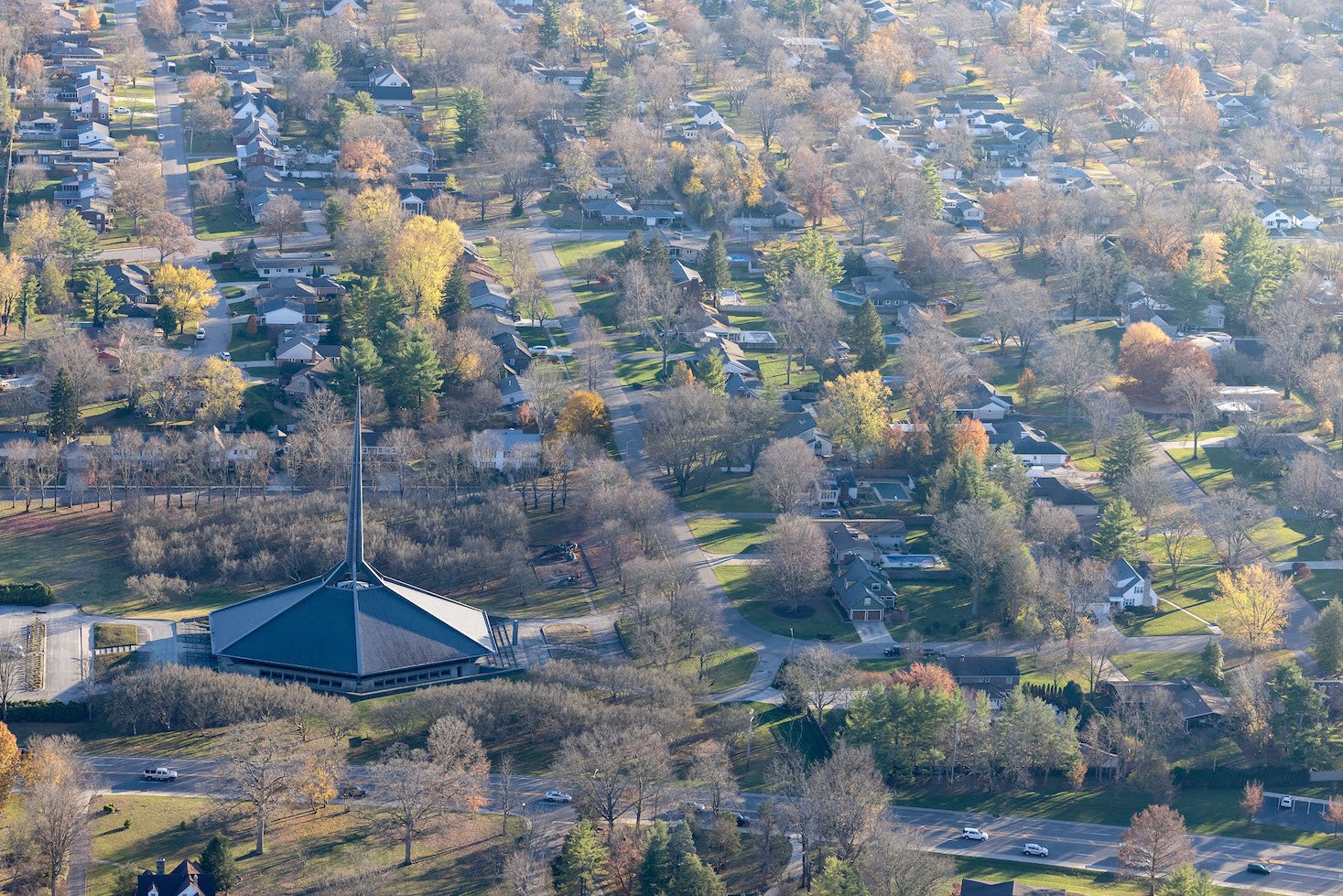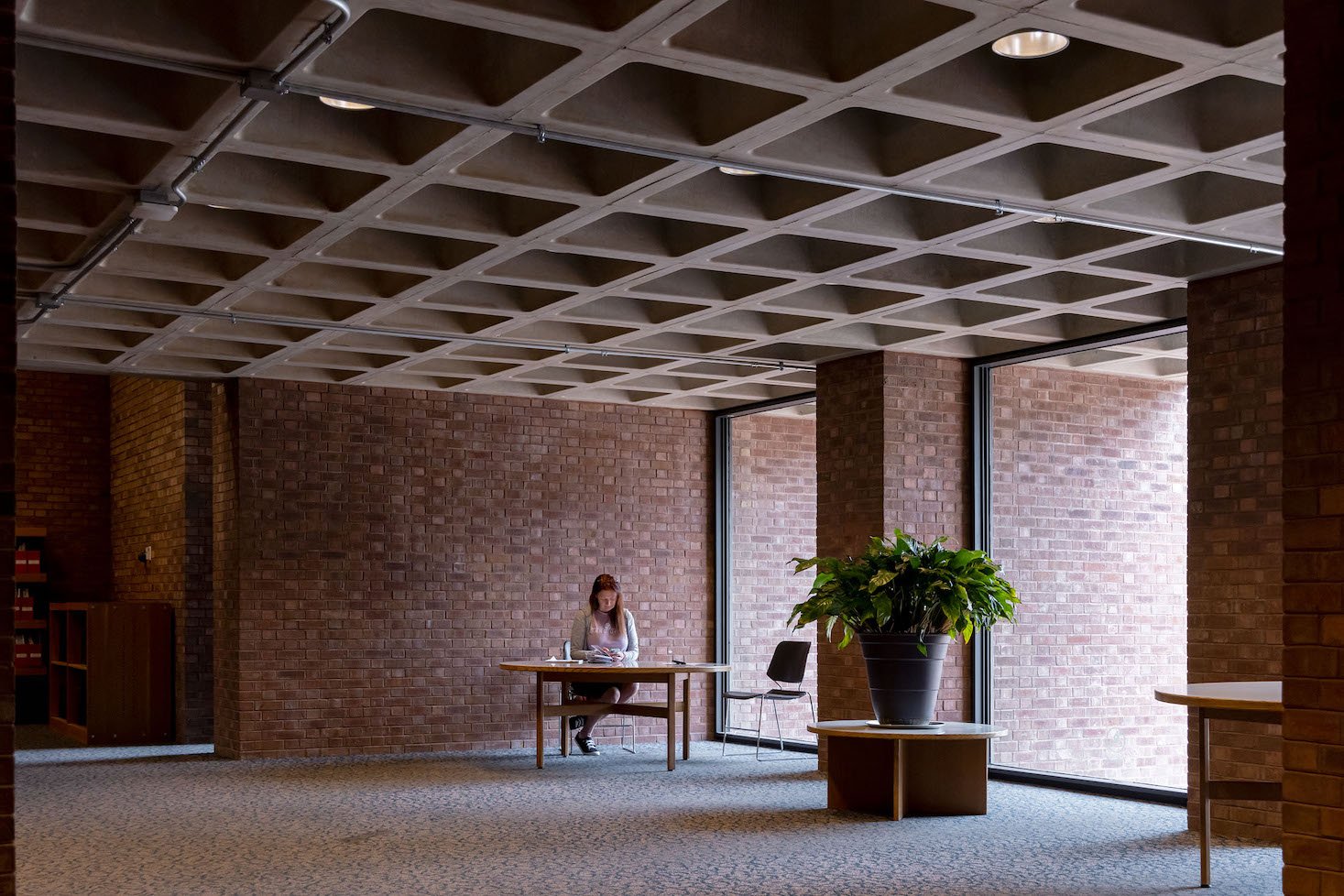
An enterprising publisher could have a lot of fun (though not necessarily make a lot of money) producing an illustrated map of America and calling it A Tour of Small-Town Modernism. Page by page, this hand-dandy travel guide would lead the archi-tourist through some of the lesser-known hotbeds of 20th-century design, carrying them from New Canaan, Connecticut, to Sarasota, Florida, to Boulder, Colorado. The itineraries could vary, and everyone could pick their own. But there’s one place where all roads would simply have to lead.
Columbus—the one in southern Indiana, not its larger counterpart in central Ohio—is the poster child for American Modernism beyond the big cities. Its population of 51,000 could just about fit in Yankee Stadium, and the nearest international airport is in Indianapolis, more than 50 miles away. Bisected by the east fork of the White River, the seat of semirural Bartholomew County is an old-fashioned American town like they hardly make ’em anymore, complete with the Lions Club, the Rotarians, a 4-H chapter, and an annual Scottish Festival, taking place in September on the fairgrounds just next to Southside Elementary.
What makes Columbus different? Well, for starters, Southside Elementary was designed by Eliot Noyes, one of the most important figures in the history of American design, and one of 40-some outstanding architects whose projects are scattered all across Columbus.
“The town has an exceptional record of […] incorporating beauty into city development,” writes Matt Shaw in American Modern: Architecture; Community; Columbus, Indiana (Monacelli). The author, a longtime fixture of various national architecture publications, knows whereof he speaks: A Columbus native, Shaw grew up in some of the very schools, churches, and landscapes he describes in the book, bringing a personal touch that pairs nicely with his erudition and that makes this almost certainly the most thorough monographic treatment of the town’s history to date. At its center is an attempt to show what quality architecture can do for a community like Columbus—to provide “a blueprint,” as Shaw puts it, for creating “that sense of connectivity that can only be grounded in authentic places and experiences.”

Chapter by chapter, the book traces the chronology (albeit not always linearly) of Columbus’s unlikely ascent into the annals of design history. From the middle years of the 19th century, the Irwin-Sweeney-Miller unit had been among the town’s foremost citizens, owners of a series of local businesses and builders of its most distinguished prewar residence, the 1910 Irwin Family Home and Gardens. The impressive Edwardian mansion was the childhood home of Joseph Irwin Miller: Born just a year before its completion, the young scion was no doubt influenced by his extraordinary surrounds, and came to evince a strong belief in the power of architecture to shape the way people think and act. His ambition, as he would later put it, was to make Columbus “the very best community of its size in the country.” Upon assuming the reins of family-owned engine manufacturer Cummins Inc., Miller set out to do just that.
Following a couple of trial commissions (including the Millers’ own exquisite 1957 home, designed with Eero Saarinen), the entrepreneur’s efforts began in earnest in 1960, with the establishment of the Architecture Program as a formal apparatus of the nonprofit Cummins Foundation. The initiative was not the sole factor in the town’s subsequent trajectory—new projects and ideas would be advanced by a “a host of individuals and companies,” Shaw notes—but it would be the most significant, covering the design fees for any major building in town on the single condition that the architect be selected from a pre-approved list.
Canvassing his wide circle of acquaintances in the business and cultural elite, Miller assembled a lineup that included some of the most prominent architects of the era—some already well established, others only at the beginning of their careers. Besides Saarinen and Noyes, I.M. Pei would eventually make the cut, along with Kevin Roche, Harry Weese, Richard Meier, Charles Gwathmey, Robert Venturi, and a host of others. The only consistency in Miller’s picks was a preference for what he termed “the best thinking of our time”—for designers who, like their patron, viewed both architecture and society as subjects for constant improvement and innovation.
Heady stuff, it might be said, for a small Midwestern factory town. Yet the projects that the program has yielded over the ensuing 60 years are remarkably practical, often simple in form, and woven deftly into the fabric of the community. They include Gwathmey’s Pence Place Housing development (1984), a well-tempered jumble of vernacular, gabled rooflines; Venturi’s Fire Station No. 4 (1968), which balances its pop iconicism with functional simplicity; and Deborah Berke’s Hope Library (1998), which brings it all back home with a delicately detailed, quasi-industrial brick box.

For those seeking visual pizazz, there are a few standouts—pre-dating the program proper, Eliel Saarinen’s First Christian Church (1942) is something like the mascot of the whole initiative, and appears on the book’s cover—yet for the most part, Miller and his compatriots did not go for grand statement, responding instead to the practical needs of their fellow Columbians and producing architecture they could live with for decades, mostly happily.
Mostly. For all its triumphs, the Cummins/Miller experiment was not without its struggles, and the author is candid about the bumps in the road the team encountered along the way. By the late 1960s, “there were concerns that the Cummins-funded architects had become too ambitious,” Shaw writes, compounded by a few missteps (in particular, César Pelli’s ambitious but flawed Columbus Commons mall, from 1973) and leading to a curtailment in the program’s activities in the years that followed.
More recently, however, the town has come to recognize its architectural heritage as a major asset, celebrated annually with Exhibit Columbus, a summertime exhibition-cum-open house that puts the community’s built environment front and center. Seen as an extension of that booster-ish endeavor, American Modern is a terrific handbook, and the photographic portfolios—shot by the formidable Iwan Baan—that bookend the lengthy essayistic passages place an emphasis on the everyday-ness of the featured buildings, showing them in the course of their quotidian operations.
For the out-of-state visitor, the only thing the book really lacks is the one thing that would make it a truly indispensable companion to any Columbus visit: a detailed map. There’s one on the back cover, but it’s too general and abstract for a dedicated road-tripper. Cartographers, take note!
The book American Modern: Architecture; Community; Columbus, Indiana will be the focus of the July 25 gathering of the New York Architecture + Design Book Club, a quarterly book subscription and event series organized by Untapped and the Brooklyn bookshop Head Hi. The program will feature the book’s author, Matt Shaw, and its designer, Alex Lin, in conversation with landscape designer Sara Zewde, who contributed to the 2022–2023 edition of Exhibit Columbus. Find out more and RSVP on the book club’s website.